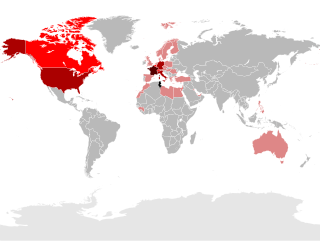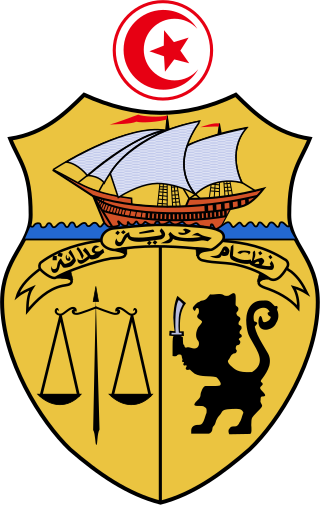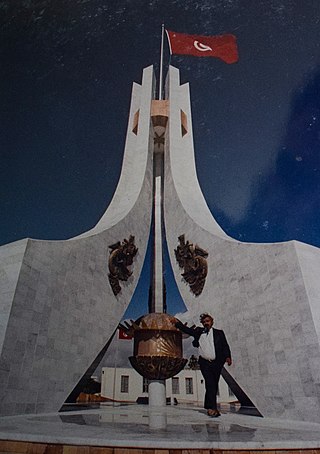
The national flag of France is a tricolour featuring three vertical bands coloured blue, white, and red. It is known to English speakers as the Tricolour, although the flag of Ireland and others are also so known. The design was adopted after the French Revolution, where the revolutionaries were influenced by the horizontally striped red-white-blue flag of the Netherlands. While not the first tricolour, it became one of the most influential flags in history. The tricolour scheme was later adopted by many other nations in Europe and elsewhere, and, according to the Encyclopædia Britannica has historically stood "in symbolic opposition to the autocratic and clericalist royal standards of the past".

The national flag of Ivory Coast is a tricolor flag consisting of equal bands of orange, white, and green. The proportions of the flag are 2:3. It is the national emblem of the Republic of Ivory Coast as affirmed in Article 29 of the Constitution of Ivory Coast in 1960.

The flag of Mauritania is a green field containing a gold star and crescent, with two red stripes at the top and bottom of the field. The original national flag was introduced under the instructions of President Moktar Ould Daddah and the constitution of 22 March 1959 and was officially adopted on 1 April 1959.

The flag of the Central African Republic was officially adopted in 1958. It has been retained since that time with the same design, four horizontal stripes of blue, white, green and yellow, and a single vertical band of red, with a yellow five-pointed star in the upper left corner.

The flag of Haiti is the national flag of the Republic of Haiti. It is a bicolour flag featuring two horizontal bands coloured blue and red, emblazoned by a white rectangular panel bearing the coat of arms of Haiti. The coat of arms depicts a trophy of weapons atop a green hill and a royal palm symbolizing independence. The palm is topped by the Cap of Liberty. The motto L'Union fait la Force appears on a white ribbon below the arrangement.

Tunisian culture is a product of more than three thousand years of history and an important multi-ethnic influx. Ancient Tunisia was a major civilization crossing through history; different cultures, civilizations and multiple successive dynasties contributed to the culture of the country over centuries with varying degrees of influence. Among these cultures were the Carthaginian – their native civilization, Roman, Vandal, Jewish, Christian, Arab, Islamic, Turkish, and French, in addition to native Amazigh. This unique mixture of cultures made Tunisia, with its strategic geographical location in the Mediterranean, the core of several civilizations of Mare Nostrum.

Muhammad VII al-Munsif, ) commonly known as Moncef Bey was the Bey of Tunis between 19 June 1942 and 14 May 1943. He was the penultimate ruler of the Husainid dynasty.

Muhammad VIII al-Amin commonly known as Lamine Bey, was the last Bey of Tunis, and also the only King of Tunisia.

Tunisians are the citizens and nationals of Tunisia in North Africa, who speak Tunisian Arabic and share a common Tunisian culture and identity. In addition to the approximately 12 million residents in Tunisia, a Tunisian diaspora has been established with modern migration, particularly in Western Europe, namely France, Italy and Germany. The vast majority of Tunisians are Arabs who adhere to Sunni Islam.

The coat of arms of Tunisia displays a Carthaginian galley along with a lion holding a sword, and a weighing scale. In the centre, just under the ship, is the national motto written in Arabic: Freedom (حرية) - Order (نظام) - Justice (عدالة). The central emblem of the national flag is seen above the shield. The background is gold in all sections.
The Établissement de la Radiodiffusion-Télévision Tunisienne (ERTT) – French for Tunisian Radio and Television Establishment – was Tunisia's state broadcasting organization from 1990 until 2007 before it was split into the Tunisian Television Establishment and the Tunisian Radio Establishment. It operated two national television channels and several radio stations.
The mass media in Tunisia is an economic sector. Under the authoritarian regimes of Habib Bourguiba, and then Zine el-Abidine Ben Ali, it saw periods of liberalization and then challenges, notably due to Tunisian censorship. The 2010-2011 Tunisian protests and the subsequent change in government may bring significant change in this domain.

The Conventions of La Marsa supplementing the Treaty of Bardo were signed by the Bey of Tunis Ali III ibn al-Husayn and the French Resident General Paul Cambon on 8 June 1883. They provided for France to repay Tunisia's international debt so it could abolish the International Debt Commission and thereby remove any obstacles to a French protectorate in Tunisia. It was in the Conventions of La Marsa that the term 'protectorate' was first employed to describe the relationship between France and the Regency of Tunis. As the first protectorate to be established, Tunisia provided a working model for later French interventions in Morocco and Syria.

Sophie Bessis is a Tunisian-born French historian, journalist, researcher, and feminist author. She has written numerous works in French, Spanish, and English on development in the Maghreb and the Arab world, as well as the situation of women denouncing the identity imprisonment to which they are subjected. She is the recipient of the Paris Liège literary prize and was honored as Commandeur of the Order of the Republic.

The National Monument of the Kasbah, more simply called the National Monument, is a memorial monument and a prominent symbol of several events in Tunisia. It is located in the center of the Kasbah Square in Tunis, facing the Town Hall.
Abdelwahab Bouhdiba was a Tunisian academic, sociologist, and Islamologist.

Mohamed Hédi Chérif was a Tunisian historian and academic. He specialized in the modern and contemporary history of Tunisia.

Chedly Ayari was a Tunisian politician, economist, and diplomat. He served in several ministerial positions under the government of Habib Bourguiba and was President of the Central Bank of Tunisia from 24 July 2012 to 16 February 2018.
Mohamed El Aziz Ben Achour is a Tunisian politician and historian born on 5 January 1951; he specializes in urban, social and cultural history of modern Tunisia and the Islamic civilization. He was the Minister of Culture some time between 2004 and 2008, and later Director-General of the Arab League Educational, Cultural and Scientific Organization (ALECSO) some time between 2009 and 2013.

The motto of Tunisia is Freedom, Order, Justice.





































